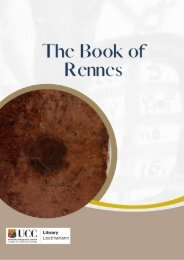Lead Toxicity in Mute Swans
LEAD TOXICITY IN MUTE SWANS Cygnus olor (Gmelin). By JOHN O'HALLORAN A thesis submitted to the National University of Ireland in candidature for the degree of Doctor of Philosophy September 1987
LEAD TOXICITY IN MUTE SWANS
Cygnus olor (Gmelin).
By
JOHN O'HALLORAN
A thesis submitted to the National University of Ireland
in candidature for the degree of Doctor of Philosophy
September 1987
Create successful ePaper yourself
Turn your PDF publications into a flip-book with our unique Google optimized e-Paper software.
toxic lea? l~vels. The post-mortem exam<strong>in</strong>ations <strong>in</strong> this study revealed<br />
the first mc1dence of a <strong>Mute</strong> Swan ~atality ~aused by lead poison<strong>in</strong>g <strong>in</strong><br />
Ireland. The syn:ptoms were consistent with the f<strong>in</strong>d<strong>in</strong>gs of previous<br />
workers. Both Simpson et al (1979) and Birkhead (1981) refer to the<br />
ab~orr:ial car:iag~ ?f the neck .as a pronounced symptom of lead<br />
poisomng. This cltmcal feature 1s caused by partial paralysis of the<br />
alimentary track that <strong>in</strong>hibits peristalsis with a resultant clogg<strong>in</strong>g of<br />
the gizzard, proventriculus and eventually the oesophagus.<br />
Jordan and Bellrose (1951) found impacted gizzards <strong>in</strong> 44% of<br />
lead poisoned ducks and a dist<strong>in</strong>ct starvation syndrome, which<br />
resulted <strong>in</strong> an enlarged gallbladder, a symptom also found <strong>in</strong> this<br />
study. ·<br />
Quantitative chemical analysis of soft tissues employed <strong>in</strong> this<br />
<strong>in</strong>vestigation provided sufficient evidence to <strong>in</strong>crim<strong>in</strong>ate lead as the<br />
cause of fatality. The level of lead <strong>in</strong> the liver of the poisoned bird<br />
( 44. 3 µg/ g wet matter) exceeds the level (SO~tg/ g dry matter 0111.z.i'µg/ g<br />
wet matter) widely recognised as lethal <strong>in</strong> plumbism. Similarly the<br />
kidney lead level (111. 78µg/ g w .m.) exceed the limit (125µg/g d.m.<br />
or 31.25µg/g w .m.) required to confirm death due to lead poison<strong>in</strong>g.<br />
(Clarke and Clarke 1975, Birkhead 1982). The blood lead was also<br />
greatly elevated. Little data on the diagnostic value of the rema<strong>in</strong><strong>in</strong>g<br />
tissues is published. Nevertheless, the levels found <strong>in</strong> kidney, liver and<br />
other tissues were greater than that of the cygnet by many orders of<br />
magnitude and were presumably toxic (Table 6).<br />
The toxic effect of lead on the kidneys of many organisms<br />
<strong>in</strong>clud<strong>in</strong>g swans is under <strong>in</strong>tensive <strong>in</strong>vestigation (Birkhead 1982 and<br />
Chisholm 1971). Much of the excess lead is concentrated <strong>in</strong> the form<br />
of dense <strong>in</strong>clusion bodies <strong>in</strong> the nucleii of the proximal and distal<br />
tubule cells (Locke, Bagley and Irby 1966).<br />
The significance of the <strong>in</strong>clusion bodies found <strong>in</strong> this study were<br />
that they were located <strong>in</strong> the nucleus, mitochondria and cytoplasm.<br />
Although the size and number of <strong>in</strong>clusion bodies is known to vary<br />
Table 6<br />
Details of two swans taken for post mortem<br />
LEAD<br />
Sex<br />
Age<br />
Nr. of<br />
<strong>Lead</strong> shot<br />
<strong>in</strong><br />
Gizzard<br />
µg/lOOmls<br />
µg/gm (wet matter)<br />
Blood Breast \ Heart Kidney Liver<br />
Muscle<br />
Pancreas<br />
Male<br />
Sub-Adult<br />
4<br />
652 4.24 57.34 11!.78 44.43<br />
43.78<br />
Male<br />
Cygnet<br />
0<br />
18.6 1.86 2.4 5.11<br />
- 146 -.
















